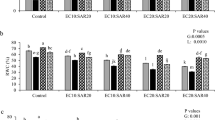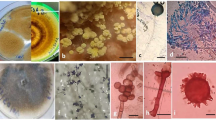Abstract
Lotus glaber is a glycophytic, perennial legume from Europe that occurs widely in saline habitats. We evaluated the effect of mycorrhizal fungus colonization on the response to salt stress of two genotypes of L. glaber differing in their tolerance to salinity. The experiment consisted of a randomized block design with two factors: (1) mycorrhizal fungus treatments (with or without AM fungus) and (2) two salinity levels of 0 and 200 mM NaCl. Our results indicated that Glomus intraradices established a more efficient symbiosis with the tolerant than with the sensitive genotype. G. intraradices improved growth of L. glaber plants under saline conditions. They showed higher values of net growth, shoot/root and K+/Na+ ratios, and protein concentrations than controls. Tolerant AM plants also showed higher chlorophyll levels than non-AM ones. Prevention of Na+ accumulation in the plant and enhancement of K+ concentrations in roots observed in this work could be part of the general mechanism of salt stress alleviation of L. glaber by G. intraradices.
Similar content being viewed by others
References
Al-Karaki GN (2000) Growth of mycorrhizal tomato and mineral acquisition under salt stress. Mycorrhiza 10:51–54
Al-Karaki GN, Hammad R (2001) Mycorrhizal influence on fruit yield and mineral content of tomato grown under salt stress. J Plant Nutr 24:1311–1323
Augé RM (2000) Stomatal behaviour of arbuscular mycorrhizal plants. In Arbuscular mycorrhizas: physiology and functions. In: Kapulnik Y, Douds DD (eds), Kluwer Academic Publishers, Dordrecht, pp 201–237
Bradford M (1976) A rapid and sensitive method for the quantitation of microgram quantities of protein utilizing the principle of protein dye-binding. Ann Biochem 72:248–254
Chen S, Li J, Wang S, Hüttermann A, Altman A (2001) Salt, nutrient uptake and transport, and ABA of Populus euphratica: a hybrid in response to increasing soil NaCl. Trees 15:186–194
Feng G, Zhang FS Li XL, Tian CY, Tang C, Rengel Z (2002) Improved tolerance of maize plants to salt stress by arbuscular mycorrhiza is related to higher accumulation of soluble sugars in roots. Mycorrhiza 12:185–190
Finlay R, Söderström B (1992) Mycorrhiza and Carbon Flow to the soil. In: Allen MF (eds), Mycorrhizal functioning. An integrative plant-fungal process. Chapman and Hall, New York, pp 134–162
Flowers TJ, Yeo A (1986) Ion relations of plant under drought and salinity. Aust J Plant Physiol 25:75–91
Fodor F, Cseh E, Varga A, Zaray G (1998) Lead uptake, distribution and remobilization in cucumber. J Plant Nutr 21:1363–1373
Gemma JN, Koske RE, Habte M (2002) Mycorrhizal dependency of some endemic and endangered Hawaiian plant species. Am J Bot 89:337–345
Giri B, Mukerji KG (2004) Mycorrhizal inoculant alleviates salt stress in Sesbania aegyptica and Sesbania grandiflora under field conditions: evidence for reduced sodium and improved magnesium uptake. Mycorrhiza 14:307–312
Giri B, Kapoor R, Mukerji KG (2003) Influence of arbuscular mycorrhizal fungi and salinity on growth, biomass, and mineral nutrition of Acacia auriculiformis. Biol Fert Soils 38:170–175
Goss MJ, de Varennes A (2002) Soil disturbance reduces the efficacy of mycorrhizal associations for early soybean growth and N2 fixation. Soil Biology and Biochemistry 34:1167–1173
Grant WF (1999) Interspecific hybridization and amphydiploidy of Lotus as it relates to phylogeny and evolution. In: Beuselinck PR (eds), Birdsfoot Trefoil: The Science and Technology of Lotus. Am Soc Agr pp. 43–60
Gupta R, Krishnamurthy KV (1996) Response of mycorrhizal and nonmycorrhizal Arachis hypogeae to NaCl and acid stress. Mycorrhiza 6:145–149
Hirrel MC, Gerdemann JW (1980) Improved growth of onion and bell pepper in saline soils by two vesicular-arbuscular mycorrhizal fungi. Soil Sci Soc Am J 44:654–655
Juniper S, Abbott L (1993) Vesicular-arbuscular mycorrhizas and soil-salinity. Mycorrhiza 4:45–57
Lichtenthaler HK (1987) Chlorophylls and carotenoids: pigments of photosynthetic membranes. Method Enzymol 148:350–382
McConigle TP, Miller MH, Evans DH, Fairchild GL, Swan JA (1990) A new method which gives an objective measure of colonization of roots by vesicular-arbuscular mycorrhizal fungi. New Phytol 115:495–501
McArthur DAJ, Knowles R (1993) lnfluence of Vesicular-Arbuscular Mycorrhizal Fungi on the Response of Potato to Phosphorus Deficiency. Plant Physiol 101:147–160
McMillen BG, Juniper S, Abbott LK (1998) Inhibition of hyphal growth of a vesicular-arbuscular mycorrhizal fungus in soil containing sodium chloride limits the spread of infection from spores. Soil Biol Biochem 30:1639–1646
Mendoza RE, Pagani EA (1997) Influence of phosphorus nutrition on mycorrhizal growth response and morphology of mycorrhizae in Lotus tenuis. J Plant Nutr 20:625–639
Montes L (1988) Lotus tenuis. Revista Argentina de Producción Animal 8:367–376
Mujica MM, Rumi CP1998 A technique of vegetative propagation by stem cuttings was fitted to Lotus tenuis. Lotus Newslett 29
Munns R (2002) Comparative physiology of salt and water stress. Plant Cell Environ 20:239–250
Munns R, Passioura JB (1984) Effect of prolonged exposure to NaCl on the osmotic pressure of leaf xylem sap from intact, transpiring barley plants. Aust J Plant Physiol 25:497–507
Paz R, Sánchez D, Pieckenstain F, Maiale S, Sannazzaro A, Cuevas J, Chiesa A, Bona G, Ruiz O (2005) Molecular and biochemical approximation of polyamine roles in tolerance mechanisms to salt stress in Lotus spp. Lotus Newslett 35:31–32
Pfeiffer CM, Bloss HE (1987) Growth and nutrition of guayule (Parthenium argentatum) in a saline soil as influenced by vesicular-arbuscular mycorrhiza and phosphorus fertilization. New Phytol 108:315–321
Philips JM, Hayman DS (1970) Improved procedures for clearing roots and staining parasitic and vesicular-arbuscular mycorrhizal fungi for rapid assessment of infection. T Brit Mycol Soc 55:158–161
Plenchette C, Fortin JA, Furlan V (1983) Growth responses of several plants species to mycorrhizae in a soil of moderate P fertility. I. Mycorrhizal dependence under field conditions. Plant Soil 70:199–209
Porcel R, Ruiz-Lozano JM (2004) Arbuscular mycorrhizal influence on leaf water potential, solute accumulation, and oxidative stress in soybean plants subjected to drought stress. J Exp Bot 55:1743–1750
Powell CL (1975) Potassium uptake by endotrophic mycorrhizas (Griselinia littoralis, Glomus microcarpus, Fungi). In Endomycorrhizas; Proceedings of a Symposium. p. 461–468
Ruiz-Lozano JM, Azcon R (2000) Symbiotic efficiency and infectivity of an autochthonous arbuscular mycorrhizal Glomus sp. from saline soils and Glomus deserticola under salinity. Mycorrhiza 10:137–143
Ruiz-Lozano JM, Azcon R, Gomez M (1996) Alleviation of salt stress by arbuscular-mycorrhizal Glomus species in Lactuca sativa plants. Physiol Plantarum 98:767–772
Sannazzaro A, Ruiz O, Albertó E, Menéndez A (2004) Presence of different arbuscular mycorrhizal infection patterns in roots of Lotus glaber plants growing in the Salado River basin. Mycorrhiza 14:139–142
Zhu JK, Liu JP, Xiong LM (1998) Genetic analysis of salt tolerance in Arabidopsis: evidence for a critical role of potassium nutrition. Plant Cell 10:1181–1192
Acknowledgements
This work was supported by grants from the Consejo Nacional de Investigaciones Cienfíficas y Técnicas (CONICET, Argentina), the Agencia Nacional de Promoción Científica y Tecnológica (PICT 14194), the EU-INCO Lotassa Project, Comisión de Investigación Científica (CIC), The Iberoamerican network for biofertilizers Biofag (CYTED). A.I.S is a CONICET fellow, A.B.M. is a researcher of the Universidad de Buenos Aires (UBA) and CONICET. O.A.R. and E.O.A. are members of the research committee of CONICET.
Author information
Authors and Affiliations
Corresponding author
Rights and permissions
About this article
Cite this article
Sannazzaro, A., Ruiz, O.A., Albertó, E.O. et al. Alleviation of salt stress in Lotus glaber by Glomus intraradices . Plant Soil 285, 279–287 (2006). https://doi.org/10.1007/s11104-006-9015-5
Received:
Accepted:
Published:
Issue Date:
DOI: https://doi.org/10.1007/s11104-006-9015-5




